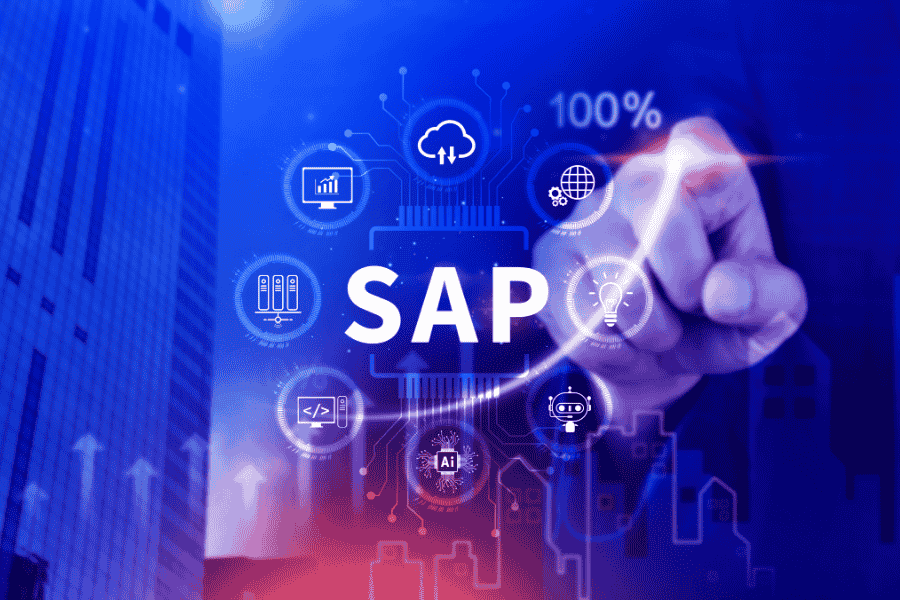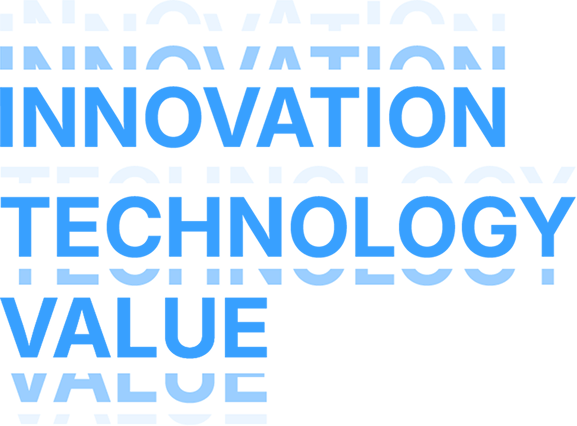Fragmented data used to present a significant hurdle for retailers to deliver truly personalized experiences and drive growth. Yet, things have changed with the emergence of technology. Among those, the customer data platform emerges as a transformative solution, lifting the retail industry to a new level. Understanding your customer is no longer an advantage but a necessity.
Accordingly, this article will be a thorough explanation about CDPs, exploring how they unify disparate customer information, thus empowering strategic decisions and unlocking unparalleled customer engagement and operational efficiency opportunities. We will delve into their core capabilities, practical applications, and the strategic imperative for their adoption in an increasingly data-driven world.
What is Customer Data Platform (CDP) & Why Does It Matter Now?
A Customer Data Platform (CDP) represents a fundamental shift in how businesses approach customer intelligence. It is a sophisticated data unification engine that collects information from websites, mobile applications, CRM systems, POS systems, e-commerce platforms, and offline channels, then combines these disparate touchpoints into a comprehensive customer profile. This unified database doesn’t just store information; it actively tracks customer interactions over time and resolves identity stitching challenges to create what industry experts call a 360-degree customer view.
As proof of its importance, the CDP market’s rapid growth with CAGRs ranging from 24.4% to 39.9% between 2024-2030. For industries like Japan, South Korea, or Southeast Asia, this expansion is no surprise. There is a critical business problem that fragmented data scattered across multiple systems severely slows down effective personalization and customer engagement. Not to mention, as internet penetration surges and e-commerce sectors expand throughout the region, consumer behaviors shift toward digital-first experiences that demand seamless, personalized interactions across all touchpoints.
In other words, organizations are gradually recognizing how unified customer intelligence translates to revenue expansion and operational efficiency.
What is the difference between CDP, CRM, & DMP?
For enterprise leaders navigating the complex data landscape across Asia, distinguishing between Customer Data Platforms (CDPs), Customer Relationship Management (CRM) systems, and Data Management Platforms (DMPs) may be challenging, yet crucial for strategic advantage. Each platform emerged to address specific business needs during different technological eras.
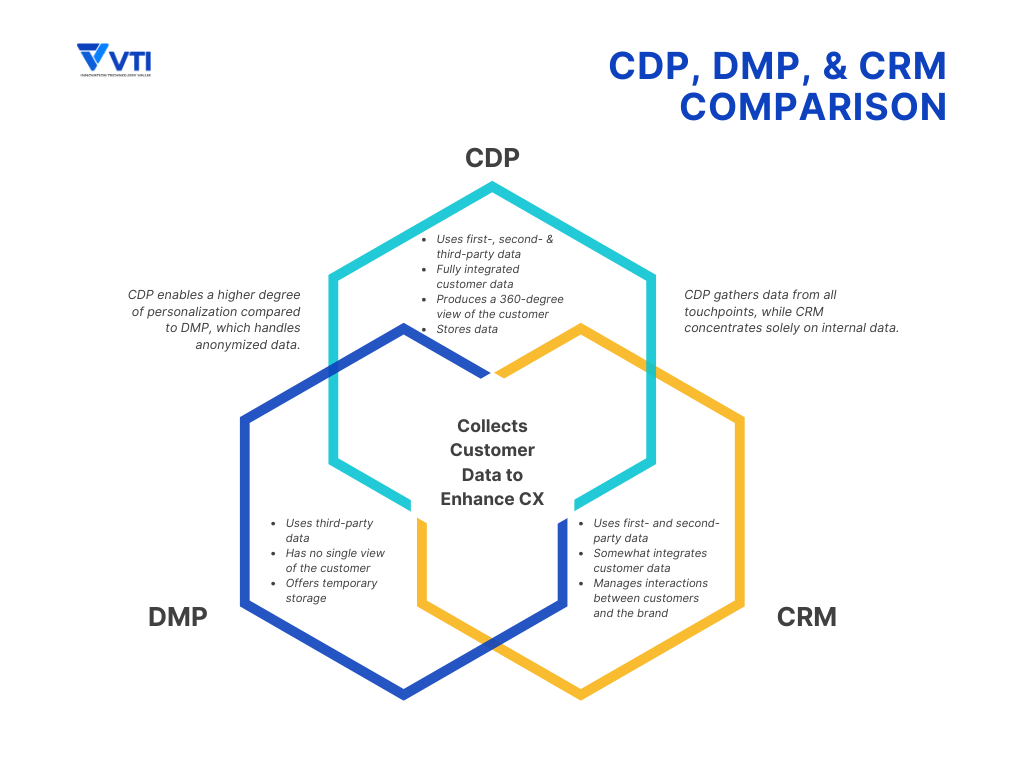
CRM:
CRM excels at managing sales pipelines and logging customer interactions using primarily first-party, identified data. It is like your company’s super secretary who knows all about your customers, their purchase history, and every conversation your sales team has had with them.
These platforms support sales teams and customer service operations effectively. But being unable to unify anonymous digital behaviors (clicking, mouse-hovering,…) or aggregate data across diverse touchpoints leads to a limitation. This is troublesome, especially when customers have a growing intention to seamlessly move between super-apps like WeChat or Grab, social commerce platforms, and physical stores.
DMP:
Meanwhile, the fundamental difference between DMPs and CDPs lies in their approach to customer data and personalization capabilities. While DMPs focus on anonymous audiences for advertising purposes, CDPs create unified customer profiles for comprehensive experience management.
DMPs focus on advertising efficiency by aggregating large volumes of third-party, often anonymized data to optimize ad targeting and media spend. Imagine DMP as a massive library that categorizes anonymous website visitors into groups like “luxury car shoppers” or “frequent travelers” without knowing their actual names.
While powerful for campaign performance, these platforms provide limited visibility into individual customer journeys and aren’t designed for long-term customer profile building or personalization beyond advertising contexts. A DMP might know that someone in Tokyo frequently visits luxury fashion websites, but it can’t connect this behavior to other touchpoints or create a personalized journey across channels.
CDPs, on the other hand, act like a master detective that pieces together all customer interactions into a single, comprehensive profile. They combine first-party data (what customers tell you directly) with behavioral data (what they do on your website or app) to create a 360-degree view of each customer, enabling real-time personalization across all touchpoints.
A Brief Comparison Guide
| Best Use Case | Manage sales teams and track deal progress, interaction history. Nurture existing, known customers | Optimize ad spend and reach. Find lookalike customers. | Create personalized experiences across all customer touchpoints, online to offline. |
| Data Type | First-party, identified data | Third-party, anonymous data | First-party + third-party, both identified and anonymous |
| Primary Function | Sales pipeline management, customer service | Ad targeting, media buying optimization | Real-time personalization, customer journey orchestration |
| Limitation | Cannot track anonymous visitors or unify cross-channel behavior | Limited individual customer insights, primarily for advertising use only | Higher implementation complexity, cost, and requirement for data governance expertise |
From this, it is worth noting that there is no standalone solution. CDPs complement existing CRM systems by enriching sales and service records with holistic behavioral insights, enabling more personalized engagement throughout the customer lifecycle. Or, they enhance DMP capabilities by providing robust first-party data foundations for targeted advertising while also enabling deeper, consent-based personalization and loyalty initiatives. And vice versa.
How a Customer Data Platform Drives Business Growth and Efficiency?
Unlocking Revenue Growth Through Enhanced Customer Intelligence
A Customer Data Platform represents a modern response to the need for unified customer profiles that span both online and offline. As mentioned, CDPs centralize first (directly from customers), second (from partners), and third-party (from external) data from multiple sources, creating a single, actionable view of each customer, including both identified and anonymous behaviors. This comprehensive perspective enables hyper-personalized marketing engagements across all touchpoints, fostering customer loyalty and encouraging repeat purchases.
The measurable benefits are significant. Seamless customer journeys tailored to individuals can increase retention rates up to 30% and boost Customer Lifetime Value up to 25%. There are real-world implementations to demonstrate. For example, a shoemaker retailer achieved a 5:1 increase in Return on Ad Spend (ROAS) for paid search ads and generated $1.4 million in revenue from a $500,000 campaign after implementing CDP solutions.
Furthermore, CDP solutions optimize marketing spend by enabling precise targeting of high-value segments while reducing wasteful expenditure. Many marketers report achieving payback within 6 months, with 4 out of 5 seeing positive ROI within 12 months.
Transforming Marketing Precision and Customer Service Excellence
The most compelling use case of CDP involves hyper-targeted marketing campaigns that leverage rich customer profiles combining demographics, behaviors, and purchasing histories. Enterprises can deploy these unified insights to create personalized email campaigns, optimized digital advertising, and dynamic website experiences that significantly improve campaign effectiveness and ROI.
This capability can also extend seamlessly into customer service operations, where the CDP customer view empowers support agents to deliver faster, more informed interactions. In markets like Japan and South Korea, where service excellence drives brand loyalty, this enhanced customer service capability becomes a critical competitive differentiator. Support teams can instantly access complete customer histories, preferences, and previous interactions, enabling them to resolve issues more efficiently while providing personalized recommendations.
Accelerating DX and Operational Excellence Through Data-Driven Insights
Beyond marketing optimization, CDPs accelerate digital transformation initiatives by modernizing data infrastructure and enabling real-time decision-making capabilities.
For retail, one example is a more informed inventory management system and purchasing decisions based on granular customer insights and demand forecasting. A proper customer data platform can collect and organize all the data necessary to perform better inventory planning and optimization by connecting necessary modules, ranging from product management, order management, to supply chain management systems. By analyzing purchase patterns and customer behavior, retailers can predict which products will be in high demand and adjust stock levels accordingly, reducing both overstock and stockout situations while enhancing operational efficiency.
The APAC region has fast-moving consumer markets, with high demand fluctuation and an omnichannel-towards tendency. This context sheds light on this predictive capability to shine even more.
Besides, CDPs enable proactive retention strategies by identifying at-risk customer segments early through comprehensive data analysis. Shiseido, the multinational cosmetics company from Japan, uses the Treasure Data enterprise CDP to increase customer retention and saw an overall increase in revenue of 11% after one year. This early warning system allows businesses to deploy timely, personalized offers or engagement tactics tailored to culturally diverse APAC markets, where customer lifetime value is vital for sustainable growth.
How to Implement a CDP: A Simple Guide for Decision-Makers
Choosing the Right CDP Vendor
Picking a Customer Data Platform is like choosing the right toolbox for your business. You need tools that work well together and fit your specific needs.
In Asia-Pacific, this choice becomes even more important because each country has different digital systems and rules.
What to Look for When Choosing Your CDP
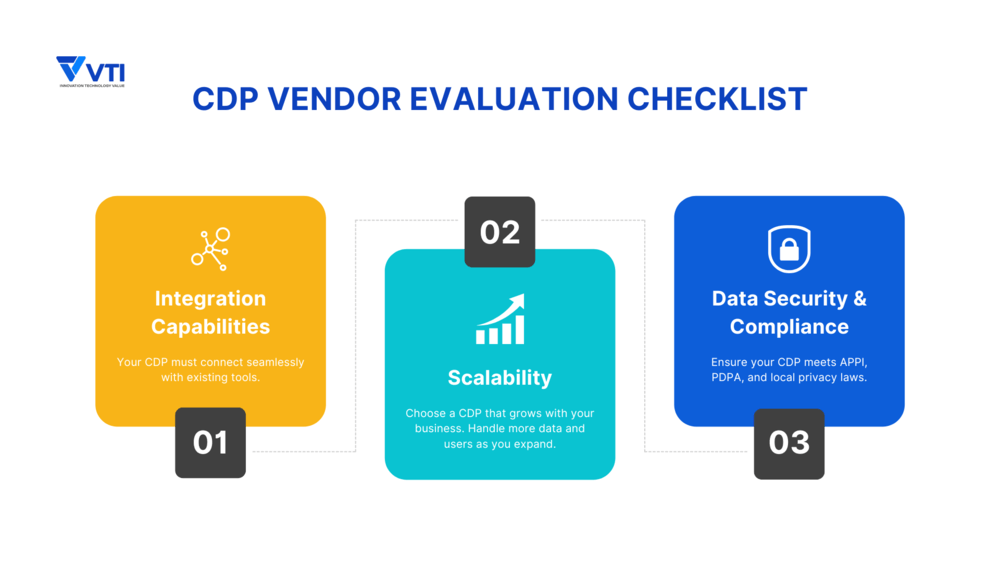
Integration Capabilities: How well does it connect with your existing system? Your CDP should connect smoothly with your current system: POS, CRM, online store, marketing tools, and analytics software. In Asia-Pacific, where businesses use many different types of technology, this “friendship between” systems is crucial.
Scalability: Choose a CDP that can grow with you, like buying clothes for a growing child with room to expand. Your platform should handle more customers and data as your business grows, which is especially important in fast-growing Asian markets.
Data Security and Compliance: This is like having a good security system for your house. Different Asian countries have different privacy laws – Japan has APPI, Singapore has PDPA, and each country has its own rules. Your CDP must follow these rules to keep customer data safe.
Top 5 CDP Vendors in Asia You Should Know
Treasure Data:
This is like having a super-smart librarian who can instantly find any book from millions of volumes. Treasure Data uses AI to combine all your customer information into one complete picture. It’s especially strong in Japan, Singapore, and Australia, and works great for retail, banking, and manufacturing companies.
VTI:
It is like having a local craftsman who builds exactly what you need, backed by a team of 1,500+ skilled workers across Vietnam, Japan, South Korea, and Singapore. VTI is like your neighborhood expert who speaks your language and understands your local business culture, and also a trusted mechanic who not only fixes your car but also teaches you how to keep it running smoothly.
They specialize in helping traditional businesses (factories, retail stores, banks, and transportation companies) become smart, data-driven companies. Their solutions include powerful features like unusual patterns detection, predictive maintenance, and demand forecasting.
The best part? VTI creates everything from scratch based on your specific needs, so you get exactly what your business requires. No more, no less.
Antsomi CDP 365:
Think of Antsomi as your local neighborhood expert who knows exactly how Southeast Asian customers behave. Born in Singapore, this CDP understands the unique shopping habits across Malaysia, Indonesia, Vietnam, and Philippines. It’s like having a marketing assistant that can predict what your customers want before they even know it themselves. Perfect for retail and banking companies.
Tealium AudienceStream:
This is like having a lightning-fast messenger who can deliver personalized messages to customers the moment they show interest. Tealium processes customer data in real-time, which means you can respond to customer actions instantly. It’s user-friendly – even people who aren’t tech experts can use it easily. Great for retail, finance, and media companies.
Twilio Segment:
Think of Segment as a master engineer’s toolkit – it’s built for tech-savvy companies who want to customize everything. With 450+ connections to other business tools, it’s like having a universal adapter that works with any device. It’s especially good for technology companies and online stores that need flexible, developer-friendly solutions.
Common Challenges and How to Overcome Them
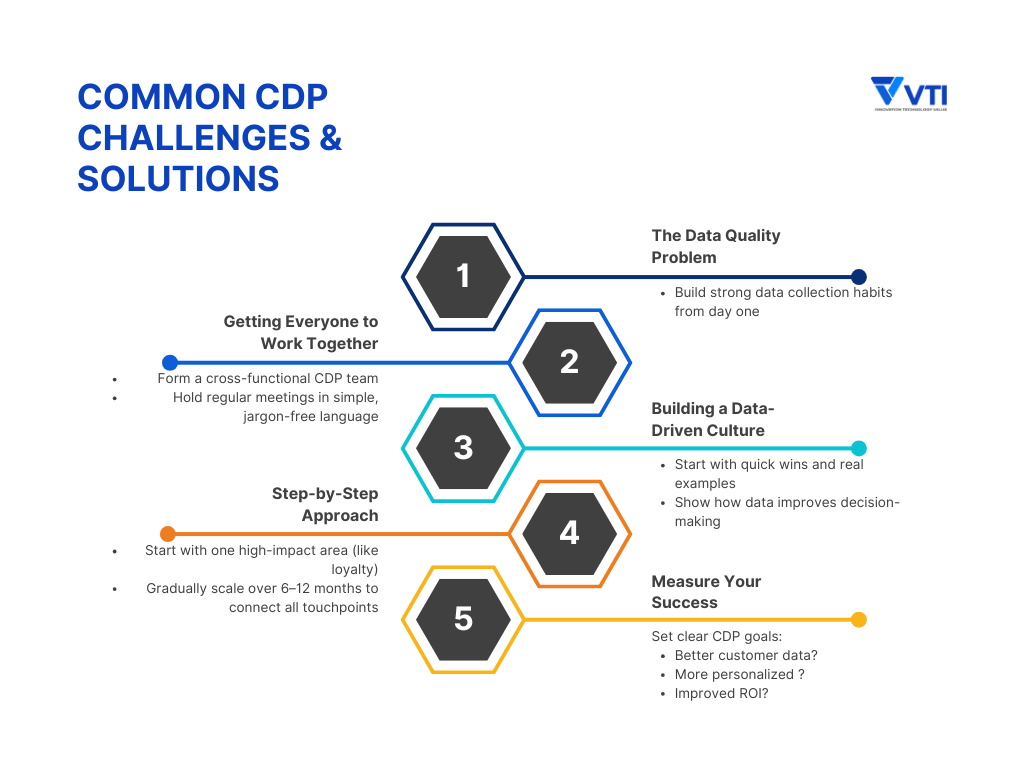
The Data Quality Problem
Many businesses face the “garbage in, garbage out” problem. If you put messy, incomplete data into your CDP, you’ll get messy results. It’s like trying to cook with spoiled ingredients – the final dish won’t taste good.
To deal with that, set up strong data collection processes from the beginning. Check your data quality regularly, like a chef tasting food while cooking.
Getting Everyone to Work Together
Imagine trying to organize a family reunion where everyone speaks different languages. That’s what happens when sales, marketing, IT, and compliance teams don’t communicate well during CDP implementation.
So, it is better to create a project team with representatives from each department. Hold regular meetings where everyone can share their needs and concerns in simple terms.
Building a Data-Driven Culture
Most companies in Asia-Pacific are not truly data-driven yet. It’s like having a gym membership but never going to exercise. The tools are there, but people don’t use them effectively.
Therefore, start small with quick wins. Show people how customer data helps them do their jobs better. For example, demonstrate how knowing a customer’s purchase history can help sales teams make better recommendations.
Take a Step-by-Step Approach
Don’t try to do everything at once. It’s like learning to drive – you start in an empty parking lot before hitting the highway.
First, start with one important area, like your online store or loyalty program.
Secondly, once that’s working well, expand to other departments
Finally, connect all your customer touchpoints
This approach usually takes 6-12 months, but it’s better to do it right than to rush and make mistakes.
Measure Your Success
Finally, it is a must to set clear goals and track your progress accordingly. Here are some questions you might want to consider to set a clear goal:
- Are we getting better customer data than before?
- Can we create more personalized experiences?
- Are our marketing campaigns more effective?
Final words
In an era defined by data and evolving customer expectations, CDP stands out as an indispensable tool for business leaders. From unifying fragmented data points into a single, actionable customer profile to empowering personalized experiences and driving significant ROI. Undoubtedly, CDPs are reshaping how businesses interact with their customers. Embracing a CDP is not merely a technology upgrade; it’s a strategic investment in deeper customer understanding, greater operational efficiency, and sustained competitive advantage. For large business owners, retail managers, or CXOs, the time to leverage CDP to build lasting customer relationships and unlock new avenues for growth is now.
Ready to unify your customer data and revolutionize your business? Explore how a robust Customer Data Platform can transform your customer engagement and drive measurable growth. Contact our experts today for a personalized consultation.
![[FREE EBOOK] Strategic Vietnam IT Outsourcing: Optimizing Cost and Workforce Efficiency](https://vti.com.vn/wp-content/uploads/2023/08/cover-mockup_ebook-it-outsourcing-20230331111004-ynxdn-1.png)


